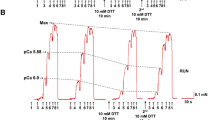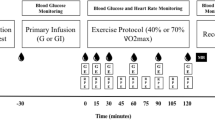Summary
The effects of two types of acute exercise (1 h treadmill running at 20 m· min−1, or 6 × 10-s periods at 43 m · min−1, 0° inclination), as well as two training regimes (endurance and sprint) on the sensitivity of epitrochlearis muscle [fast twitch (FT) fibres] to insulin were measured in vitro in rats. The hormone concentration in the incubation medium producing the half maximal stimulation of lactate (la) production and glycogen synthesis was determined and used as an index of the muscle insulin sensitivity. A single period of moderate endurance as well as the sprint-type exercise increased the sensitivity of la production to insulin although the rate of la production enhanced markedly only after sprint exercise at 10 and 100 μU· ml−1 of insulin. These effects persisted for up to 2 h after the termination of exercise. Both types of exercise significantly decreased the muscle glycogen content, causing a moderate enhancement in the insulin-stimulated rates of glycogen synthesis in vitro for up to 2 h after exercise. However, a significant increase in the sensitivity of this process to insulin was found only in the muscle removed 0.25 h after the sprint effort. Training of the sprint and endurance types increased insulin-stimulated rates of glycolysis 24 h after the last period of exercise. The sensitivity of this process to insulin was also increased at this instant. Both types of training increased the basal and maximal rates of glycogen snythesis, as well as the sensitivity of this process to insulin at the 24th following the last training session. It was concluded that in the epitrochlearis muscle, containing mainly FT fibres, both moderate and intensive exercise (acute and repeated) were effective in increasing sensitivity of glucose utilization to insulin. Thus, the response in this muscle type to increased physical activity differs from that reported previously in the soleus muscle, representing the slow-twitch, oxidative fibres in which sprint exercise did not produce any changes in the muscle insulin sensitivity.
Similar content being viewed by others
References
Armitage P (1971) Statistical Methods in Medical Research. John Wiley & Sons, New York
Bedford TG, Tipton CM, Wilson NC, Oppliger RA, Gisolfi CV (1979) Maximum oxygen consumption of rats and its changes with various experimental procedures. J Appl Physiol 47:1278–1283
Bjorntorp P, Fahlen M, Grimby G, Gustafson A, Holm J, Renstrom P, Schersten T (1972) Carbohydrate and lipid metabolism in middle-aged, physically well-trained men. Metabolism 21:1037–1044
Budohoski L, Challiss RAJ, McManus B, Newsholme EA (1984a) Effects of analogues of adenosine and methyl xantines on insulin sensitivity in soleus muscle of the rat. FEBS Lett 167:13
Budohoski L, Challiss RAJ, Lozeman FJ, McManus B, Newsholme EA (1984b) Increased insulin sensitivity in soleus muscle from cold exposed rats: reversal by adenosine-receptor agonist. FEBS Lett 175:402–406
Challiss RAJ, Espinal J, Newsholme EA (1983) Insulin sensitivity of rates of glycolysis and glycogen synthesis in stripped soleus, epitrochlearis and hemidiafragm muscle isolated from sedentary rats. Biosci Rep 3:675–679
Davies TA, Klahr S, Tegetmeyer ED, Osborne DF, Howard TL, Karl IE (1986) Glucose metabolism in epitrochlearis muscle of acutely exercised and trained rats. Am J Physiol 250 (Endocrinol Metab 13):E137-E143
Dietze GJ (1982) Modulation of the action of insulin in relation to the energy state in skeletal muscle tissue. Possible involvement of kinins and prostaglandins. Mol Cell Endocrinol 25:127–149
Espinal J, Challiss RAJ, Newsholme EA (1983a) Effect of adenosine deaminase and adenosine analogue on insulin sensitivity in soleus muscle of the rat. FEBS Lett 158:103–106
Espinal J, Dohm GL, Newsholme EA (1983b) Sensitivity to insulin of glycolysis and glycogen synthesis of isolated soleus muscle strips from sedentary and exercise-trained rats. Biochem J 212:453–458
Garetto LP, Richter EA, Godman MN, Ruderman NB (1984) Enhanced muscle glucose metabolism after exercise in the rat: the two phases. Am J Physiol 246 (Endocrinol Metab 9): E471-E475
Hultman E (1967) Muscle glycogen in men determined in needle biopsy specimens. Methods and normal values. Scand J Clin Lab Invest 19 [Suppl 91]:1–63
James DE, Kraegen EW, Chisholm DJ (1985) Effects of exercise training on in vivo insulin action in individual tissues of the rats. J Clin Invest 76:657–666
Langfort J, Budohoski L, Newsholme EA (1988) Effect of various types of acute exercise and exercise training on the insulin sensitivity of rat soleus muscle measured in vitro. Pflügers Arch 412:101–105
Leighton B, Budohoski L, Lozeman FJ, Challiss RAJ, Newsholme EA (1985) The effect of prostaglandins E1, E2, F2 and indomethacin on the sensitivity of glycolysis and glycogen synthesis to insulin in stripped soleus muscle of the rat. Biochem J 227:337–340
Reaven GM (1980) Insulin-independent diabetes mellitus: metabolic characteristics. Metabolism 29:445–454
Richter EA, Garetto LP, Goodman MN, Ruderman NB (1982) Muscle glucose metabolism following exercise in the rat: increased sensitivity to insulin. J Clin Invest 69:785–793
Richter EA, Garetto LP, Goodman MN, Ruderman NB (1984) Enhanced muscle glucose metabolism after exercise: modulation by local factors. Am J Physiol 246 (Endocrinol Metab 9): E476-E482
Ruderman NB, Ganda OP, Johansen K (1979) The effect of physical training on glucose tolerance and plasma lipids in maturity-onset diabetes. Diabetes 28:89–92
Sonne B, Galbo H (1980) Simultaneous determinations of metabolic and hormonal responses, heart rate, temperature and oxygen uptake in running rats. Acta Physiol Scand 109:201–209
Stupnicki R (1982) A single-parameter quality control in radioimmunoassay. Endocrinologie 80:48–51
Author information
Authors and Affiliations
Rights and permissions
About this article
Cite this article
Langfort, J., Budohoski, L., Kaciuba-Uściłko, H. et al. Effect of endurance and sprint exercise on the sensitivity of glucose metabolism to insulin in the epitrochlearis muscle of sedentary and trained rats. Europ. J. Appl. Physiol. 62, 145–150 (1991). https://doi.org/10.1007/BF00626771
Accepted:
Issue Date:
DOI: https://doi.org/10.1007/BF00626771




